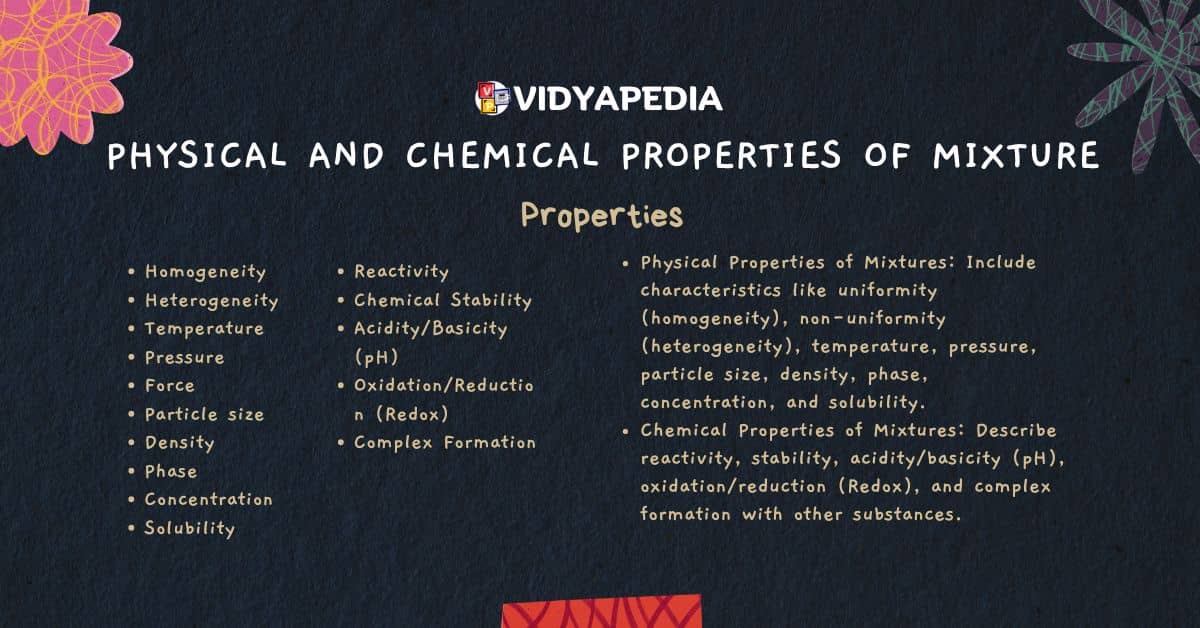The properties of mixtures play a crucial role in their presence and behavior in the environment. Physical properties such as temperature, pressure, force, particle size, and movement define how mixtures behave physically. On the other hand, chemical properties determine how mixtures interact with substances like humidity, water, colloidal solutions, and various compounds. These characteristics are essential for understanding the nature and applications of mixtures in different contexts, as discussed in the sections below.
In the explanation of physical properties, concepts like homogeneity and heterogeneity are defined, along with discussion on separation methods such as filtration, distillation, evaporation, magnetic separation, and centrifugation. Additionally, aspects such as particle size, force, concentration, density, and solutions are examined.
Concerning chemical properties, the focus is on detailing phenomena like non-reactivity, reactions with other substances, reactivity, and chemical stability. These topics provide a comprehensive understanding of how mixtures behave and interact under different conditions.
Physical Properties of mixtures
- Homogeneity and heterogeneity: These terms describe how evenly or unevenly the components are spread throughout the mixture. A homogeneous mixture, like a well-mixed solution, is uniform throughout, affecting its clarity and ease of mixing. On the other hand, a heterogeneous mixture, such as a suspension with varying particle concentrations, can separate over time or with specific treatments.
- Density: The density of a mixture is determined by the densities of its individual components and their relative amounts. It dictates how much mass is packed into a given volume and influences phenomena like floating, sinking, and layering in mixtures.
- Phase: Whether a mixture is solid, liquid, or gas greatly impacts its physical properties. Changes in temperature and pressure can cause phase transitions, such as melting or vaporization, affecting the mixture’s stability and behavior.
- Concentration: The concentration of substances within a mixture affects its properties like color intensity, taste, and chemical reactivity. A highly concentrated solution, for example, may behave differently in terms of solubility and reaction rates compared to a dilute one.
- Solubility: This refers to how well a substance dissolves in a solvent to form a uniform mixture. Solubility is influenced by factors like temperature, pressure, and the chemical nature of the substances involved, impacting how much of a substance can dissolve and remain stable in the mixture.
- Pressure and Force: External pressures and applied forces can alter the volume, compressibility, and flow behavior of mixtures, especially in gases and liquids. Stirring or agitation (applied force) affects how components mix and interact within the mixture, influencing homogeneity, reaction rates, and separation processes.
Chemical properties of mixture
- Reactivity: Reactivity is how easily substances in a mixture react with other substances. Some mixtures react quickly when they come into contact with other things, while others stay more stable and don’t react as fast.
- Chemical Stability: Chemical stability means how well a mixture stays the same without changing. A stable mixture doesn’t break down or change much, even when the conditions around it change.
- Solubility: Solubility is about how well a substance dissolves in another substance, often water. If something is very soluble, like sugar in water, it dissolves easily. If it’s not very soluble, like oil in water, it doesn’t dissolve well and stays separate.
- Acidity/Basicity (pH): Acidity and basicity tell us if a mixture is more like an acid or a base. The pH scale measures this from 0 to 14, where 7 is neutral. Substances with a pH below 7 are acidic, like lemon juice. Those above 7 are basic, like soap. pH affects how things mix and react with each other.
- Oxidation/Reduction (Redox): Oxidation and reduction are types of chemical changes where substances either gain or lose oxygen or electrons. These reactions are important because they can change how mixtures behave and their properties.
What are the main differences between homogeneous and heterogeneous mixtures?
Homogeneous mixtures are uniform throughout, meaning you can’t see the different parts because they’re mixed evenly, like salt dissolved in water. Heterogeneous mixtures, on the other hand, aren’t uniform, and you can see the different parts, like a salad with various vegetables.
What factors affect how stable mixtures are?
The stability of mixtures depends on factors like the types and concentrations of substances, temperature, pressure, and the presence of other chemicals or external influences.


